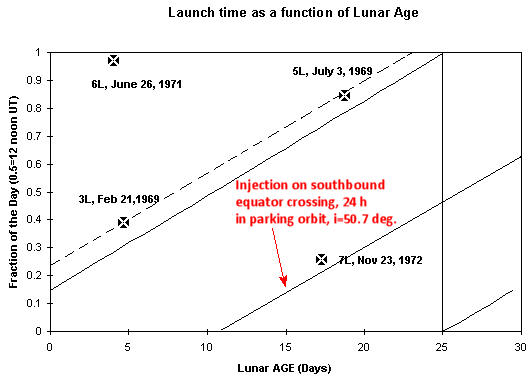
Nature of the 7K-L1S spacecraft
Sven Grahn
Table of contents
| Date | Spacecraft | Launcher | Time of launch | Comments |
|---|---|---|---|---|
| 21.02.69 | 7K-L1S no.3 | 11A52 No.3L | 09:18:07 UT | Fire in the tail of rocket; exploded after 70 sec of flight. |
| 03.07.69 | 7K-L1S no.5 | 11A52 No.5L | 20:18:32 UT | LOX pump was disabled; Rocket exploded on launch pad right away after launch |
| 26.06.71 | Mock-up LOK+ mock-up LK | 11A52 No.6L | 23:15:07.5 UT | Blown up after 51 sec |
| 23.11.72 | Mock-up LOK+ mock-up LK | 11A52 No.7L | 06:11:52 UT | Fire in the propulsion system;exploded after 107 sec |
The launch on June 26, 1971 is sometimes said to have occured on June 27. It indeed did take place on June 27, Moscow Time.
A method to calculate the launch time (expressed in fractions of a day, UT) has been developed. It is a very simplistic method and does not take into account the detailed astrodynamics near the Moon. It is based on the simple assumption that the Moon (at the time of arrival) must be close to the orbital plane of the low parking orbit (before trans-lunar injection). Using a function of Launch time v.s. Age of the Moon that fits well with the Zond flights and assuming that the flight time to the Moon for the N-1 launches would be roughly the same (3.3 days) we can derive a hypothetical launch time based on the age of the Moon at the day of launch. This time is called "Launch time to reach the Moon" below. The difference column shows the difference between actual and hypothetical launch time. Only for 3L and 5L is this difference small enough to say with certainty that the target was the Moon. The two other flights were not aimed at the moon (unless TLI occured on a southbound leg of the parking orbit, which is improbable).
| N-1 | Date | Launch time | Age at launch | Launch time to reach moon | Difference | Comments |
|---|---|---|---|---|---|---|
| 3L | 21.02.69 | 09:18:07 UT | 4.73 | 7:23 UT | 115 min | Target = MOON |
| 5L | 03.07.69 | 20:18:32 UT | 18.76 | 18:48 UT | 90 min | Target = MOON |
| 6L | 26.06.71 | 23:15:07 UT | 4.05 | 6:50 UT | 985 min | - |
| 7L | 23.11.72 | 06:11:52 UT | 17.22 | 17:34 UT | -682 min | - |
In the figure below the N-1 launch attempts have been plotted together with the Zond Age/launch-time curve. The dashed line fits the 3L and 5L launches. A conclusion could be that the N-1 lunar launches would have used a longer flight time to the Moon and/or a different trajectory near the Moon than the Zond flights. I have also drawn a line for injecting towards the moon on a southbound pass near the equator and also for waiting 24 hours on parking orbit and a 3.3 days flight time and i= 50.7 degrees.The 7L launch is very close to this line and indicates this flight could indeed have been aimed at the Moon too. This is in agreement with a launch to the Moon as stated in (2) but in contradiction to the opinion of NSA as reported in (1). But it requires an injection on a southbound pass - never done before or after in Soviet/Russian space operations.

Only 3L and 5L carried the L-3S payload which consisted of the Zond-type vehicle 7K-L1S. The "S" designation stands for "Sputnik" according to Mr Oleg Sokolev, who worked on these missions. This means that they were intended for lunar orbit ! The 7K-L1S was very similar to the L1 spacraft, but it had the DOK (attitude control and propulsion unit used on top of the LOK) and its guidance and control subsystem was more similar to that of the LOK. If the 3L and 5L flights had been successful, the missions could not so neatly have been concealed as Zond flights. They would not have been mixed up with the Proton-launched Zond series because the fact that they entered lunar orbit pointed to a larger launch vehicle.
![]()
![]() [Sven's
Space Place]
[Sven's
Space Place]
![]() [Space
History Notes]
[Space
History Notes]
![]()
Copyright © 1996 Sven
Grahn